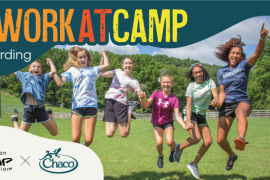Sometimes having the right activity at the right moment can make the difference between a good day and a great day at camp! Here are some no-planning, no-equipment-necessary games that you can play with your campers. (Find these and 98 other nature activities in 101 Nature Activities for Kids, by Jane Sanborn and Elizabeth Rundle.)
Scenario #1: You’ve got five minutes before lunch starts and you need a quick game that won’t get your campers too riled up.
Activity: Cloud Races
Have campers lie down, look up in the sky, and pick a cloud to watch race by. Choose a point as a finish line and see whose cloud crosses it first.
Scenario #2: Your campers are feeling extra energized this afternoon and you want to let them blow off some steam.
Activity: Balance of Nature
This predator-prey game demonstrates the concept that nature is said to be in a state of balance when the populations of animals and plants are in such proportions that everyone has food without damaging the well-being of another species. Divide the group into three equal groups, with one group representing grass, one representing mice, and one representing bobcats. Each group should have a specific physical sign that distinguishes it from the others. For example, the players in the grass group might wave their arms above their heads to look like blades of grass blowing in the wind. In designating these groups, be sure to play up the importance of the grass and the mice or everyone will want to be a bobcat.
When the game begins, the bobcats try to catch the mice, the mice try to catch the grass, and the blades of grass try to catch the bobcats. The reasoning behind the grass chasing the bobcats is that when bobcats die, their bodies decompose, fertilize the soil, and provide nourishment for the grass. If a chaser/predator succeeds in tagging his prey, the prey then changes species and becomes whatever tagged him and they both continue trying to tag other players. It is wise to set boundaries. After a few minutes of play, call all the players back and count the number of each species that is left, and then let the tagging start again.
After a few more minutes, call them back and count them off again. Often, the previously dying species will have made a remarkable recovery. The students can see that population is important and that it establishes a balance. If only a few mice are left, plenty of grass will be available for them to eat, and their predators (the bobcats) will have a harder time finding them. Therefore, it is likely that the mice will make a comeback. This exercise can be repeated as many times as you like, and different scenarios will play out each time. It can also bring about a great discussion if you introduce one predator who can tag anyone in the game. How does this addition impact the balance of nature?
Scenario #3: You’re on a hike and want to take a moment for the group to get creative.
Activity: The Stick Game
While hiking, have each camper pick up a stick that he thinks resembles an object. He must then use his stick as though it were that object. For example, a camper may find a stick that looks like a big spoon, so he would pretend like he was eating from it, or a camper may find a stick that looks like a broom, so he would pretend like he was sweeping with it. Campers can either explain what their sticks are supposed to be or have others guess.
Additional Resources
- More nature activity books and DVDs.
- Learn about the importance of nature activities and find examples of more games in “Creating Community through Nature,” from the 2011 September/October Camping Magazine.




